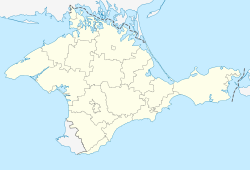
Back غورزوف Arabic Qurzuf AZ قورزوف AZB Гурзуф BE Gurzuf Catalan Hurzuf CEB Gurzuf CRH Гурзуф CV Hursuf German Gurzufo EO
Gurzuf
Гурзуф | |
|---|---|
| Coordinates: 44°33′10″N 34°17′15″E / 44.55278°N 34.28750°E | |
| Republic | Crimea |
| Municipality | Yalta Municipality |
| Elevation | 30 m (100 ft) |
| Population (2014) | |
• Total | 8,933 |
| Time zone | UTC+3 (MSK) |
| Postal code | 98640 — 98643 |
| Area code | +7-654 |
| Former names | Gorsovium, Gorzubiti |
| Climate | Cfa |
Gurzuf or Hurzuf (Ukrainian: Гурзуф, Russian: Гурзу́ф, Crimean Tatar: Gurzuf, Greek: Γορζουβίται) is a resort town (urban-type settlement) in Yalta Municipality of the Autonomous Republic of Crimea, a territory recognized by a majority of countries as part of Ukraine but incorporated by Russia as the Republic of Crimea. Population: 8,933 (2014 Census).[1]
It is located on the northern coast of the Black Sea. It is the site of a 6th-century fortress built by Justinian I and called by Procopius the fortress of the Gorzoubitai. The fortress was later restored by the Genoese who called the place Garzuni, Grasni, and Gorzanium, and appointed it the seat of a chief magistrate.[2] It was a former Crimean Tatar village, now a part of Greater Yalta. Alexander Pushkin visited Gurzuf in 1820 and ballet master Marius Petipa died here. The International Children's Center Artek (formerly the All-Union Young Pioneer camp Artek) is situated just behind Mount Ayu-Dag (Bear Mountain). The World Organization of the Scout Movement's Eurasian Region is headquartered in the town.
Between Gurzuf and Mount Ayu-Dag is Cape Suuksu. At the top of the Cape is a tower, a medieval cemetery, and a small monument to Pushkin.
- ^ Russian Federal State Statistics Service (2014). "Таблица 1.3. Численность населения Крымского федерального округа, городских округов, муниципальных районов, городских и сельских поселений" [Table 1.3. Population of Crimean Federal District, Its Urban Okrugs, Municipal Districts, Urban and Rural Settlements]. Федеральное статистическое наблюдение «Перепись населения в Крымском федеральном округе». ("Population Census in Crimean Federal District" Federal Statistical Examination) (in Russian). Federal State Statistics Service. Retrieved January 4, 2016.
- ^ John Buchan Telfer. The Crimea and Transcaucasia. Forgotten Books, 2012. p.68.



